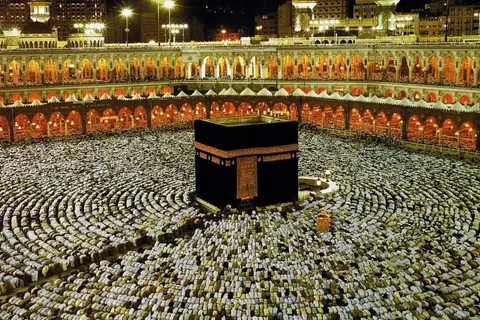Tawaf Al Ifadah explained is essential to learn for Understanding the meaning and purpose behind Tawaf al-Ifadah. It is essential for anyone learning about the Hajj pilgrimage. In this article we will explore its meaning, how to perform it and more.
What Is Tawaf al-Ifadah?
Tawaf al-Ifadah is one of the most important rites of Hajj and obligatory pillar without which the pilgrimage is not complete. The Arabic word Ifadah translates as “to pour forth” or “to flow,” but for the movement of pilgrims back to the Kaaba in Makkah after their stand at Arafat on the 9th of Dhul-Hijjah.
In short, Tawaf Al Ifadah explained as a ceremonial circumambulation of the Kaaba representing spiritual rebirth, cleansing, and submission to Allah.
This sacred Tawaf is performed after pilgrims leave Minaafter they have completed symbolically showering the Jamarat—and must be done before leaving Makkah. It is also known as Tawaf al-Ziyarah (the visit Tawaf) because it represents the pilgrim’s dignified return to Allah’s House.
Significance of Tawaf al-Ifadah in Hajj
Grasping the significance of Tawaf Al Ifadah explained makes it clear just how vital a rite this is, and why it features so prominently in the pilgrimage. Tawaf al Ifadah is not just characterized as an activity of physical act, but as a deeply affecting experience of spiritual attachment and completion.
Tawaf al Ifadah Explained as a Symbol of Spiritual Purity
After a day of standing on the Arafat plains—a day for repentance and seeking pardon—pilgrims return to the Kaaba to perform Tawaf al-Ifadah.
This act is an act of spiritual renewal. When we are thinking of having Tawaf Al Ifadah explained in this context, it’s considered purification of the heart, whereby the believer presents themselves before Allah in sincerity and devotion.
As the physical circles around Kaaba, so the heart approaches Allah, achieving the complete circuit of spiritual transformation which Hajj is intended to fulfill.
A Declaration of Submission
All through Hajj, every move illustrates humility and submission to Allah’s will. Tawaf al-Ifadah is no exception. It’s a declaration that the pilgrim has complied with the outlined steps, weathered physical hardship, and has returned to the holy core of Islam hoping to be accepted by Allah.
When Tawaf Al Ifadah explained within this framework, it’s obvious why it’s a statement of obedience, surrender, and devotion to the Creator.
The Climactic Moment of Hajj: Tawaf al Ifadah Explained
For many, Tawaf al-Ifadah is the emotional peak of the pilgrimage. It comes after the most demanding days of Hajj and is intense personal closeness to the Kaaba, the house of God.
Defining Tawaf al Ifadah as the spiritual climax of Hajj helps students to understand how it ties everything together. Tawaf Al Ifadah explained helps us remember that the pilgrimage is not just traveling to a place, but transforming in the journey.
Tawaf al Ifadah Explained as a Unifying Ritual
Pilgrims of every country, age, and background are doing Tawaf al-Ifadah in unison, circumambulating the Kaaba as one. The scene is a reflection of the cohesion of the Muslim Ummah and the oneness of all the faithful before Allah.
When Tawaf Al Ifadah explained through such a universal frame, it reminds us that Hajj is not an individual religious act, but an international declaration of Islamic brotherhood and unity.
How to Perform Tawaf al-Ifadah: Step-by-Step Guide
For beginners of Hajj or those who need to understand better, having Tawaf Al Ifadah explained step by step makes the act more personal and easier to perform. Here is a step-by-step guide to help you perform this blessed ritual with confidence and clarity.
1. Tawaf al Ifadah Explained: Prepare with the Correct Intention
Before you start, have niyyah (intention) in your heart to perform Tawaf al-Ifadah as a basic pillar of Hajj. Make sure that you have performed wudu when you enter Masjid al-Haram.
When the scholars are discussing tawaf al ifadah, they emphasize the point that true intention is the foundation of all acts of worship, especially in Hajj.
2. Begin at the Black Stone (Hajar al-Aswad)
Start your Tawaf towards the Black Stone, which is at one corner of the Kaaba. If possible, raise your right hand and say “Bismillah, Allahu Akbar.” This marks the start of the first of seven circuits.
When you have Tawaf Al Ifadah explained in a practical sense, it’s reassuring to learn that kissing or touching the Black Stone is Sunnah, not obligatory. Due to the crowds, most pilgrims only raise their hand in its direction as they proceed.
3. Walk around the Kaaba Seven Times (Counter-Clockwise)
Take seven laps around the Kaaba counterclockwise. Begin and finish each lap at the corner of the Black Stone. Men can perform raml (walk briskly) on the first three laps if the area allows.
With Tawaf Al Ifadah explained in detail, it reminds us to be patient and not push or shove other individuals. Take advantage of the opportunity to make duas and adhkar, there are no fixed supplications, so speak to Allah within your heart.
4. Make Two Rak’ahs Behind Maqam Ibrahim (If Possible)
After completing the seven circuits, pray two rak‘ahs behind Maqam Ibrahim, if you’re able to find space. Otherwise, pray anywhere in the mosque where it is convenient. This Sunnah prayer is highlighted as a way to seal the act of Tawaf with extra devotion.
5. Tawaf Al Ifadah explained: Drink Zamzam Water
Go to the Zamzam water and drink with the aim of healing, purification, and blessings. This is one of the customary practices that unite the pilgrim with the heritage of Hajar (peace be upon her) and Prophet Ibrahim (peace be upon him).
6. Do Sa’i (If Not Already Done)
In case you have not performed Sa’i (the walk between Safa and Marwah) following Tawaf Qudum, perform it now. Sa’i involves walking seven times back and forth between Safa and Marwah, reflecting on the determination and trust in Allah exhibited by Hajar.
This step is followed in accordance with the ritual sequence of the pilgrim. If Sa’i was accomplished earlier on, you do not perform it here.
7. Continue Other Hajj Rites
Having completed Tawaf al-Ifadah, the pilgrim can shave or trim the hair (if not shaved earlier), and part of Ihram limitations is lifted. It is a highlight in your Hajj journey.
With Tawaf Al Ifadah explained as such, you can now proceed with assurance that you’ve done one of the most important duties of Hajj.
Continue Your Journey of Understanding
Ready to deepen your knowledge beyond the Hajj rituals day by day? Explore these helpful guides tailored for every step of your pilgrimage:
Discover the rules of ihram for men and women and enter Hajj in a state of purity.
Learn how to perform Tawaf with confidence and focus.
Understand the sacred Sa’i between Safa and Marwah in a clear, step-by-step way.
Unsure what to do in Mina during Hajj? We’ve got you covered.
Reflect on what is the Day of Arafat and why it’s the heart of Hajj.
Prepare for the important Muzdalifah night rituals every pilgrim must know.
Follow our stoning the Jamarat guide to complete this symbolic act correctly.
Learn how to do animal sacrifice in Hajj with our complete how-to.
Get Tawaf al-Ifadah explained so you don’t miss this key ritual.
Don’t forget a thing—our Hajj packing list essentials will keep you organized.
Stay safe with expert advice on staying healthy during Hajj.
Wondering what to do after Hajj? Start your next chapter spiritually strong.
If you’re new to Islam, read our Hajj guide for new Muslims—made just for you.
Set meaningful spiritual goals for Hajj to get the most out of your journey.
Find clear answers to the most common Hajj questions answered by experts.
Dive deeper into each topic and walk your Hajj journey with clarity and peace of mind.



